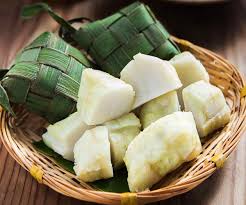Our food tour guide Mel tells us about one of the best Malay rice snacks here in Singapore, Ketupat.

This is definitely one of Malay’s food staple. It is made of cooked rice compressed and wrapped in woven coconut leaves. It is commonly found during the Ramadan period. It’s a favourite during Hari Raya.
Originating from Indonesia and Malaysia, ketupat is often consumed with Malay dishes. Favourite meals such as satay or even rendang. In Singapore, ketupat is available instant at the nearest supermarket or wet market. On our food tour we often see them hanging from the market stalls ready to be picked.
Ketupat, alternatively called ketupat nasi is made of plain rice shaped into a rhombus. This is done by wrapping it in woven coconut leaves.
How do you create the unique shape?
Malay young teenagers would learn how to weave the ketupat using the leaves at an early age. The process looks complicated but over time, it starts to make sense.
I started weaving my first ketupat at the age of 14 years old. My mum, she started back when she was 7 years old. My grandmother had 8 children and she had 5 siblings. You do the math and you could tell how big of a family she needs to feed on Hari Raya.
Thus, my grandmother started enforcing culinary skills in her kids. My mum was the youngest, so during Ramadan she picked it up. Here in Singapore we like to keep it in the family with each of us trying to be the best.
There is a saying in Malay, “Belajar anyam ketupat ni .. tak semua orang boleh. Orang yang betul betul niat nak belajar je boleh tangkap.”
Loosely translated, “Learning to weave ketupat is not for everyone. Only the keen and willing to learn will be able to master it.”
So yes, weaving the ketupat is very important. The best ketupat not only need to take the diamond shape, it has to be tight enough but not so tight to tear the leaves apart. If the ketupat is too loose it would lose it shapes and break during the boiling process. If the weaving of ketupat is too tight it will tear the leave apart.
Creation of ketupat requires a lot of tender care and love. It takes a lot of patience too. In Singapore it can be served with rendang, Soto Ayam or satay among other Malay delicacies!
So the next time you try a ketupat, enjoy it as it takes a lot of love, care and patience to create a perfect one!
Don’t forget to book the best food tour in Singapore and learn more about the Singapore food scene!
